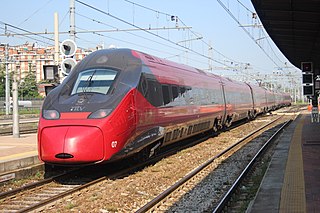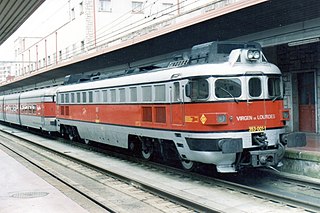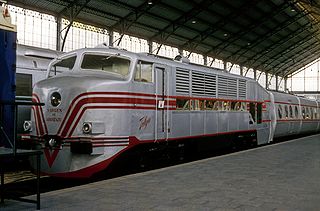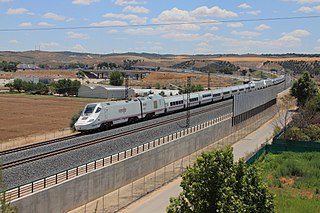
A tilting train is a train that has a mechanism enabling increased speed on regular rail tracks. As a train rounds a curve at speed, objects inside the train experience centrifugal force. This can cause packages to slide about or seated passengers to feel squashed by the outboard armrest, and standing passengers to lose their balance. Tilting trains are designed to counteract this by tilting the carriages towards the inside of the curve, thus compensating for the g-force. The train may be constructed such that inertial forces cause the tilting, or it may have a computer-controlled powered mechanism.

Pendolino is an Italian family of tilting trains used in Italy, Spain, Poland, Portugal, Slovenia, Finland, Russia, the Czech Republic, Slovakia, the UK, Switzerland and China. Based on the design of the Italian ETR 401, it was further developed and manufactured by Fiat Ferroviaria, which was taken over by Alstom in 2000.

Patentes Talgo, SAU is a Spanish listed manufacturer of intercity, standard, and high speed passenger trains. The word Talgo is also used by the rail operator Renfe for a type of inter-city rail service.

Alta Velocidad Española (AVE) is a service of high-speed rail in Spain operated by Renfe, the Spanish national railway company, at speeds of up to 310 km/h (193 mph). As of December 2021, the Spanish AVE system is the longest HSR network in Europe with 3,622 km (2,251 mi) and the second longest in the world, after China's.

InterCity is the classification applied to certain long-distance passenger train services in Europe. Such trains generally call at major stations only.
Elipsos Internacional S.A. is a Spanish company which was set up in 2001 by Spanish RENFE and French SNCF with a 50% share each. It was created to handle the logistics of Trenhotel night railway services between Spain and France, Switzerland and Italy; in 2013 only services to France remained; they were cut back to thrice a week in September 2013, and discontinued on 15 December as the high speed line between France and Spain had opened. The Elipsos Trenhotel operated with Talgo gauge change trains. Elipsos now handles high-speed trains between France and Spain, sold as "Renfe-SNCF in Cooperation".

The Renfe Class 100 is a high-speed train used for AVE services by the Renfe Operadora, in Spain. It was the first high-speed train put into service in Spain, in 1992.

The Renfe Class 102 or S-102 is a high-speed train used for the AVE service and operated in Spain by the state-run railway company Renfe, and based on Bombardier Transportation's power car technology. Outside AVE service, Talgo markets this train as the Talgo 350.

The Renfe 334 is a high speed, 4 axle diesel-electric locomotive built to haul passenger trains on Renfe's Talgo service on non electrified lines.

The Renfe Series 333 are high power six-axle diesel-electric locomotives built in the 1970s; at the time of their introduction they were the most powerful non-electric locomotives in Spain.

The Renfe Class 353, formerly known as the T-3000 are a class of diesel-hydraulic locomotives built by Krauss-Maffei for express trains in Spain.

The Renfe Class 352 was a class of twin engined four axle diesel-hydraulic locomotives built by Krauss-Maffei, designed solely for passenger traffic; in particular they were responsible for towing Andalusian Talgo III trains. The class were very successful, heralding a new era of passenger trains in Spain. They were delivered in 1964 and 1965, and were fully withdrawn during the 1990s.

The Renfe Class 354 was a series of eight diesel hydraulic locomotives manufactured by Krauss-Maffei in Germany specifically to pull Talgo pendular coaches which were introduced shortly before the acquisition of these machines.

The Renfe Class 350 is a series of four single-cabin diesel locomotives that were delivered to Spain in 1950 for use with Talgo II coaches, being built in the United States by the American Car & Foundry to a distinctly American external style.

The Renfe Class 130 or S-130 is a high-speed dual-gauge, dual-voltage trainset consisting of 11 Talgo VII tilting coaches and two power cars, used on Alvia services. The class have been nicknamed patitos (ducklings), due to the shape of the train nose.

Talgo Avril is a high-speed train that Talgo is developing. It stands for "Alta Velocidad Rueda Independiente Ligero".

The Renfe classes 319.2, 319.3 and 319.4 are six axle Co'Co' medium power mainline diesel-electric locomotives manufactured by Macosa using General Motors Electromotive division components under license.

El tren Estrella was a conventional overnight railway service provided in Spain by the national rail network operator RENFE until April 2015. Services left most major Spanish cities in the evening and usually arrived at their destination the following morning.

The Catalan Talgo was an international express train that linked Geneva, Switzerland, with Barcelona, Spain from 1969 to 2010. It was named after the Spanish region Catalonia and the Talgo equipment it used. It was an extension and upgrading of a predecessor train, Le Catalan, a first-class-only French (SNCF) Rapide train that had been in operation since 1955 but running only between Geneva and the stations nearest the Spanish-French border, connecting with a second-class-only "autorail" trainset to and from Barcelona. The national railway network of Spain, Red Nacional de los Ferrocarriles Españoles (RENFE), was using Iberian gauge for all of its main lines, while those of France and Switzerland use standard gauge. As a result of this break-of-gauge, train journeys between Geneva and Barcelona consisted of two separate parts, with travelers having to change from a French to a Spanish train or vice versa at the border—at Portbou on southbound trains and at Cerbère on northbound trains. In 1968, this was resolved with the introduction of the Talgo III RD trainsets, which featured variable gauge wheelsets. At Portbou station, the wheel spacing of each passenger carriage was adjusted by a gauge changer for the difference in gauge, and passengers no longer had to change trains. After successful test runs, the Catalan was extended from Port Bou to Barcelona as a through train on 1 June 1969, becoming the Catalan Talgo and upgraded to a Trans Europ Express (TEE). Most other rail journeys through this border crossing continued to require a change of train at Cerbère station or at Port Bou, as most trains did not use Talgo III RD trainsets.

The Renfe Class 730 or S-730 is a high-speed dual-gauge, dual-voltage and hybrid trainset consisting of 11 Talgo VII tilting coaches and two power cars, used on Alvia services. The class have been nicknamed patitos, due to the shape of the train nose. They are a variant of RENFE Class 130 modified to be able to run on both electric and diesel power, in order to extend higher-quality services to parts of Spain not on the electrified network.




















